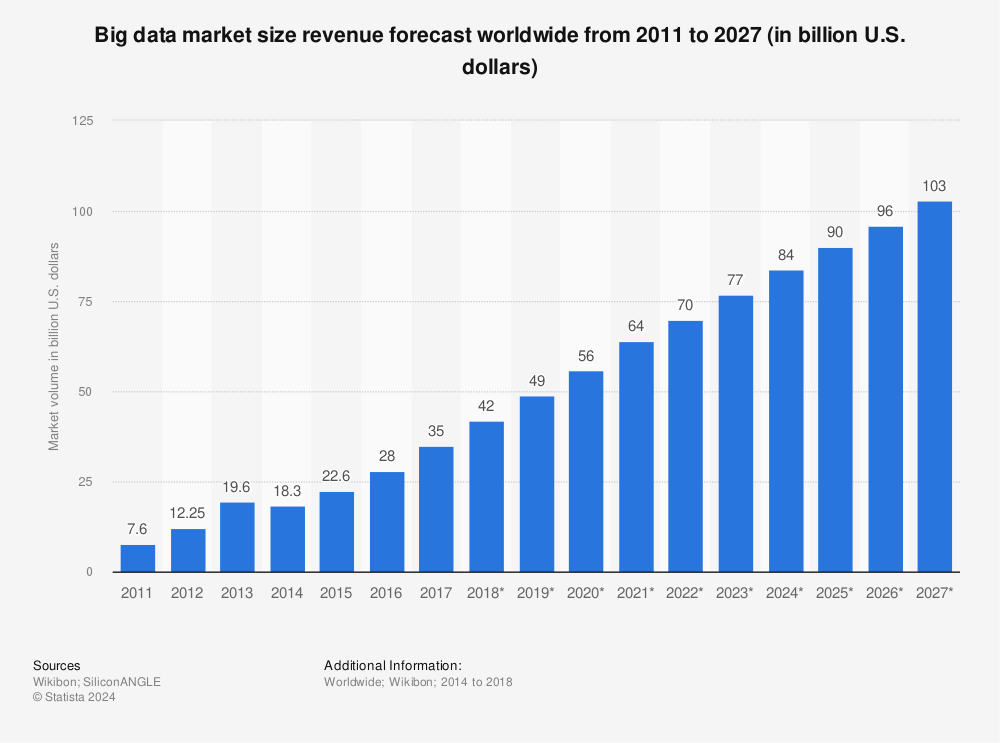Data sets that are too large or complex to be computed by any traditional data-processing software, are called Big Data. Big Data has many fields, and offers more statistical power, while data with a higher complexity like more attributes and columns, could lead to a higher false discovery rate. When you deal with Big data, it includes capturing data, data storage, analysis, sharing, search, visualization, transferring, querying, updating, data source, and information privacy. Big data is so large that traditional data processing methods cannot handle it.
Table of Contents
Big Data Statistics Trending Now

The internet has more than a billion users now, and each action of theirs online generates new data. Businesses want to use this data for collecting customer information, managing human resources, and tracking inventory, amongst other things. There’s even a new word – zettabyte, to measure the alarmingly large volumes of data that we now generate. These trillions of gigabytes of data have to be stored, analyzed, and kept secure. That is where Big data comes in. The industry is full of different talking points, from data centers and cloud services to IoT devices and predictive analysis tools.
Here are some important Big Data statistics to get you started.
- Globally, the Big Data and Analytics market are worth a massive $274 billion.
- In just a few short years, the Big data industry has seen huge growth. It went up from $169 billion in 2018 to a staggering $274 billion in 2022 which chalks up to a massive 62% increase.

- The Big Data global market may generate up to $103 billion in revenue by 2027.
- The combined growth of mobile data, machine learning, cloud computing, and the internet of things, has pushed up spending on Big Data. Its revenue is expected to grow twofold, from 20019 to 2027.
- America has a 51% market share in Big Data Analytics Solutions.
- In terms of Big Data spending, America leads all other nations by a big margin. US companies spent a cool $110 billion on Big Data in 2021. The next two spots have been taken by Japan and China, which spent around $12.4 billion and $11.9 billion respectively.
- As of now, there are over 44 zettabytes of data in the digital universe.
- We create an amazing amount of data. 2019 itself saw 4.4 ZB of data in the digital universe. The next year saw that figure increase to a massive 44 ZB of data. One zettabyte is one trillion gigabytes. That’s a huge amount of data.
- The money invested in Big Data cost savings and regulations has increased fourfold since 2019.
- Most firms spend the majority of their Big Data budget on transformation and innovation, and investments like cost savings and compliance take up the lion’s share each year. The year 2019 saw just 8.3% of investment decisions driven by such concerns. In 2022, this number went up to 35.7% of all Big Data investments.
- According to 27% of business executives, their firm’s foray into Big Data has been profitable.

- Capgemini carried out a survey of 2010 executives, half of them in America and half in Europe, to try and understand how they view their company’s big data initiatives. One-fourth of the executives reported profits, while 45%, broke even when investing in Big Data. According to 12%, they lost money on their Big Data investments.
- Budget constraints remain the biggest challenge companies face when they try to implement Big Data.
- Half of all American executives and 39% of European executives have claimed that budgetary constraints remain the biggest hurdle when they try to turn Big Data profitable. The top 5 challenges are integration challenges, a lack of technical expertise, data security concerns, and the increase in the number of data silos.
- Each year, colocation data centers make around $31.39 billion in revenue.
- Some companies don’t want to deal with on-site data storage. For them, there’s third-party data storage. This is for firms that are too small to afford their own data centers, colocation service firms are a great way to store data. Data centers are making around $30 billion today, with revenues poised to hit $58.28 by 2025.
- America has around twice as many data centers, like the UK, China and Germany combined.

- Big Data requires data centers to be stored and transmitted. There are around 2,751 data centers in America alone, offering cloud, managed and colocation data services.
- According to 43% of IT decision-makers, their IT infrastructure may not be able to bear data demands in the future.
- We are generating an increasing amount of data daily. Dell Technologies estimates that firms will need several technologies like edge computing, machine learning, and 5G just so that they can manage their data in the future.
- On average, data and AI professionals earn $146000.
- Big Data jobs offer a healthy 6-figure salary despite slow salary growth of around 2.25% each year. If we take 2021’s 7% inflation rate into account, data and AI professionals seem to lose their spending power.
- Each year, Netflix saves a billion dollars courtesy of its recommendation algorithms.

- Netflix is a great example of how powerful Big Data use may be. Its recommendation algorithm influences around 80% of all the content we watch on the platform. As a result of that, there’s better retention and a billion dollars in savings.
- According to 68% of travel brands, investing in predictive analytics or business intelligence is a given.
- Travel companies that are learning how to use Big Data can benefit in many ways. One way is to use predictive analytics to narrow down their pricing strategies, building on reputation management and boosting customer satisfaction.
- According to 72% of manufacturing executives, advanced data is required to boost productivity.
- Manufacturing executives are well aware of the power of Big Data analytics but have not learned how to implement them. According to a BCG-WEF survey, only 17% of executives claim to take advantage of data analytics.
- A healthy 1400 universities depend on predictive analytics to help them address low graduation rates.
- Around 50% of college students don’t complete their degree programs. Colleges suffering from low graduation rates are using Big Data to spot trends, and predict the future struggles of the students. Let’s take Georgia State. Using predictive analysis, this college has raised its graduation rate by 23% since 2003.
- In the healthcare industry, Big Data analytics could reach around $79.23 billion by 2028.
- Healthcare is a big market for Big Data courtesy of the growing demand for business intelligence solutions. Generating $20.12 billion in revenue in 2021, the market should grow by an average of around 28.9% yearly.
- In Supply Chain Management, Big Data spending could surpass 7 billion dollars globally by 2027.
- Thanks to the COVID-19 pandemic, supply chains were thrown out of gear. As a result of this SCM, firms turned to Big Data analytics so they could manage their inventories better and react to demand fluctuations faster.
- Approximately 57% of the world’s population uses the internet.
- Out of the 8 billion people in the world, around half spent time online in 2019. That same year saw 67% of people using mobile devices and around 45% spending time on at least one social platform.
- User-generated data makes up 70% of the world’s data.
- From social media posts to emails and customer reviews, user-generated data is everywhere. According to Baseline, there are over 900 exabytes of this data that exist.
- Every second, there are 99,284 searches on Google.

- This translates to over 6 million searches per minute, or 350 million searches per hour, or 3 trillion searches each year. As for Google, its dominance of the search engine market continues with a massive 91.9% of the global search market share.
- On average, an internet user spends around 6 hours and 58 minutes online each day.
- The internet remains at the top of our hobbies, and with more apps, devices, and platforms, the amount of time we spend online can only get higher. The average time online increases by 4 minutes daily.
- According to 72% of US adults, companies have too much control over their personal data.
- Data privacy is a touchy topic in America. With data breaches like the Facebook Cambridge Analytica scandal and practices like pervasive cookie tracking, there’s an air of mistrust that hangs around internet users.
- Unstructured digital data makes up around 80% to 90% of all data.
- Unstructured data refers to digital files that cannot be stored in traditional databases. This means text messages, emails, images, videos, and social media posts, are all unstructured. However, that data gives you the analytics and insights that can help organizations gain a competitive advantage.
- By 2023, global spending on the Internet of Things could cross a trillion dollars.
- The Internet of Things or IoT is the name given to smart devices that are constantly online. What began with the home market soon spread out to cover everything from agriculture to healthcare. By 2025, there may be over 30 billion IoT-connected devices.
- Cloud computing generates around $400 billion in revenue.
- We can divide cloud computing marketing into 3 segments. Software as a service or SaaS is led by firms like Salesforce, Adobe, and Microsoft. This is the largest segment with a size of $172 billion. IaaS or Infrastructure as a service comes next with a $122 billion market size, followed by platforms as a service or PaaS clocking at $101 billion.
- Each year, users spend $92 billion on public cloud infrastructure.
When it comes to Big Data, cost savings and efficiency are primary concerns. That is why IaaS service providers play a vital role in the future of digital businesses. If companies use a public cloud, they pay for the resources they need. - $52 billion – the value of the hybrid cloud market. A hybrid cloud gives you the scalability of the public cloud combined with the security of the private cloud. It is used by Microsoft, Netflix, Amazon, and Hulu – an industry standard. According to forecasts, the hybrid cloud market will hit $145 billion by 2026.
- 45% of firms use the cloud to take care of their Big Data workload. Most firms do not possess the computing power to handle large amounts of data on their own. Via the cloud, they can process Big Data without investing in software and infrastructure.
- 22% – that’s how much the edge computing market might grow –
- While decentralized data processing is not new, edge computing is becoming a favored way to deal with bandwidth, latency challenges, and congestion. In 2020 the edge computing market was worth just $2.49 billion. It could touch $68.71 billion by 2030.
- Firms waste up to 30% of the money that they spend on cloud computing –
- According to 750 respondents in a 2021, survey, only 70% of the firm’s cloud computing budget was allocated efficiently. AWS or Amazon Web Services owns 1/4th of all the IaaS and PaaS markets.
- $179 billion each year is generated by Infrastructure as a service (IaaS) and platform as a service (PaaS), each year. AWS has the lion’s share in that market, followed by IBM at 14.9%.
- By 2023, the insurance and telecommunications industry plans on using an average of 11.4 clouds.
- Irrespective of industry, most enterprise companies use around 8 clouds on an average. This figure is expected to grow, with insurance and telecommunications being at the top of all industries in terms of future cloud utilization.
Conclusion
The Big Data industry will most likely carry on with its rapid expansion, as long as people keep generating data. Companies will make use of fresh developments in data processing and analytics so they can serve their customers better. As firms move toward implementing Big Data technology, they need to learn how to carry it out without spending more than required. What’s more, they’ll need to find a way to win back the trust of the public stung by data breaches and privacy scandals.
Read More






